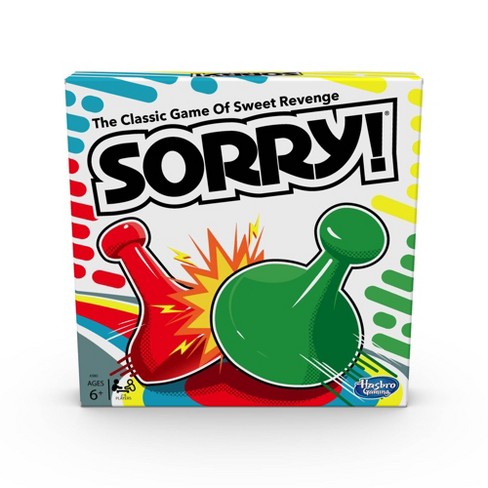Topic Sorry Board Game: Dive into the world of "Sorry Board Game," a timeless classic that blends strategy, luck, and playful competition, perfect for family game nights and creating lasting memories.
Table of Content
- YOUTUBE: How to Play Sorry
- History and Evolution of Sorry Board Game
- Gameplay and Rules
- ...
- Strategy and Tactics
- Game Components and Setup
- Card Values and Their Meanings
- Safety Zones and Winning the Game
- Variants and Alternative Gameplays
- Educational and Cognitive Benefits
- Sorry Board Game in Digital Format
- Buying Guide and Product Options
- Frequently Asked Questions
How to Play Sorry
Are you ready to play? Get ready for some exciting fun and adventure with our latest video! Watch as we dive into the world of gaming and explore new levels, challenges, and strategies. Don\'t miss out - hit that play button now!
READ MORE:
History and Evolution of Sorry Board Game
The Sorry Board Game, a beloved classic since its inception in the 1930s, originated from the ancient Indian cross and circle game Pachisi. It was first patented in England by W.H. Storey & Co in 1929 and later brought to America by Parker Brothers a few years later. This simple yet engaging game has undergone several changes over the years, including adaptations in rules, components, and even the game"s name.
With its simple rules and engaging gameplay, Sorry has remained a favorite across generations. The game"s design and gameplay have evolved, reflecting changing tastes and preferences. For instance, early versions of the game featured a diamond image on the board to guide players, which is absent in more modern versions. The classic wooden pawns of the past have been replaced with colored plastic pegs or tokens in later editions, showcasing the game"s adaptation over time.
Sorry has also expanded into the digital realm, with computer and online versions allowing players to enjoy the game virtually. This transition to digital platforms has further broadened the game"s appeal and accessibility. Additionally, various spin-offs and adaptations like Sorry! Sliders and Sorry! Express have been introduced, adding new dimensions to the game.
Despite these changes, certain elements have remained consistent, such as the iconic pawns and the overall objective of the game. These consistent elements serve as a testament to the game"s rich history while embracing innovations for the future. Today, Sorry continues to be a popular choice for family game nights, offering a blend of strategy, luck, and playful competition.

How to Play Sorry
Step into the world of Sorry Sorry Board Game and get ready for an epic gaming experience. Join us as we unravel the secrets, strategies, and excitement of this captivating game. Get your friends together, grab some snacks, and let the fun begin - click play now!
How to Play Sorry Board Game in 2 Minutes
Looking for a classic board game that never gets old? Look no further! Join us as we dive into the world of Sorry Board Game, a game that has been entertaining generations. Discover the thrill of competition, strategy, and unexpected twists. It\'s time to gather your friends or family and hit play for an unforgettable gaming session!
Gameplay and Rules
The Sorry board game is a classic, family-friendly game for 2-4 players. The objective is to be the first player to get all four of their pawns from the start area to their home space. The game is known for its simple rules and the exciting dynamics created by the game"s cards, which determine the players" moves.
Set Up
Each player chooses a color and places their four corresponding pawns in the start area of that color. Remove the sixes and nines from the deck of cards, shuffle it, and place it face down on the designated spot on the board to form the draw pile. The youngest player usually starts the game, and play proceeds to the left.
Starting the Game
To move pawns out of the start, a player must draw a 1 or a 2 from the deck. If a 1 is drawn, the pawn moves to the space directly outside of start. Drawing a 2 allows the pawn to move and the player draws again. If neither a 1 nor a 2 is drawn, the turn ends.
Moving Pawns
Pawns move clockwise around the board based on the card drawn. Only one pawn of the same color can occupy a space. If a pawn lands on a space occupied by an opponent"s pawn, the opponent"s pawn is bumped back to its start. Certain cards allow pawns to move backward, and landing on a triangle space of a different color lets a pawn slide to the end of the colored area, bumping any pawns in its way.
Safety Zones and Home
Each color has a Safety Zone leading to its Home. Pawns can only enter the Safety Zone of their color and must reach Home by exact count. Pawns in the Home area are safe and cannot be moved again.
Card Values
- 1: Move a pawn one space forward; also a starting card.
- 2: Move a pawn two spaces forward and draw again; also a starting card.
- 3, 5, 8, 12: Move a pawn forward by the number of spaces indicated on the card.
- 4: Move a pawn four spaces backward.
- 7: Move one pawn seven spaces forward or split between two pawns.
- 10: Move one pawn ten spaces forward or one space backward.
- 11: Move one pawn eleven spaces forward or switch with an opponent"s pawn.
- Sorry!: Move a pawn from start to a space occupied by an opponent"s pawn, sending their pawn back to start.
Winning the Game
The first player to get all four of their pawns into their Home space wins the game.
Variations
Several variations exist to spice up the gameplay, such as Reverse Play, Point Play, and Collection Game. These variations introduce different starting positions, goals, and methods of scoring.
...

Strategy and Tactics
While "Sorry!" is a game largely based on luck, there are several strategies and tactics players can employ to increase their chances of winning. These strategies revolve around making the most of the cards drawn, positioning pawns strategically, and making decisions that can either advance your position or hinder your opponents".
Effective Use of Cards
- Starting Moves: Use 1s and 2s to move pawns out of the start quickly. Keeping these cards to start pawns is more effective than using them for short moves on the board.
- Seven Card Split: The 7 card can be split between two pawns. Use this to move pawns into safety zones or home, or to set up strategic positions on the board.
- Backward Moves: Use 4s and 10s to move pawns backwards effectively. This can be a shortcut to your safety zone if your pawn is just beyond the start.
- Sorry! Card: Use the Sorry! card to replace an opponent"s pawn and advance one of your own from the start. Target pawns that are close to their home or safety zones for maximum effect.
Board Positioning and Movement
- Avoiding Traffic: Spread your pawns out to avoid traffic jams and to have more options on each turn.
- Blocking and Bumping: Keep track of opponents’ pawns and use your moves to block their paths or bump them back to start when possible.
- Entering Safety Zones: Aim to move pawns into your safety zone as soon as possible. This not only protects them but also puts them closer to home.
Defensive and Offensive Play
- Defensive Strategy: Sometimes it"s better to move a pawn less than the maximum allowed to avoid landing on a dangerous spot or to stay in a safe position.
- Offensive Strategy: Use high number cards to move your pawns quickly around the board, and use your pawns to block or bump opponents" pawns, especially those nearing their home.
Endgame Strategies
- Home Stretch: As you get closer to getting all your pawns home, focus on the safest routes and avoid risky moves that could send your pawns back to start.
- Team Play Variation: In team play, coordinate with your partner to block opponents and help each other get pawns home. Sharing strategies and planning moves can be crucial.
Game Components and Setup
The "Sorry!" board game is a popular family game suitable for 2-4 players. Understanding the components and setup is essential for a smooth game experience.
Game Components
- Gameboard: The board is divided into spaces, including start spaces, safety zones, home spaces, and slides.
- Pawns: 16 pawns, with 4 pawns each in four different colors (Red, Blue, Green, Yellow).
- Deck of Cards: A deck consisting of 45 cards, excluding the numbers 6 and 9, with unique actions assigned to each card.
- Instructions: A rulebook that explains the game"s rules and setup in English and Spanish.
Setup
- Choosing Pawns: Each player chooses a color and takes the corresponding four pawns.
- Placing Pawns: Players place their pawns in the matching color start spaces.
- Shuffling Cards: Shuffle the deck of cards and place them face down in the designated space on the gameboard.
- Determining the First Player: The youngest player often goes first, or you can choose another method such as drawing the highest number card to start the game.
- Dealing Cards: In some versions, each player is dealt 5 cards face down to start.
Once the setup is complete, the game can begin with the first player drawing a card from the deck and following its instructions. The game progresses with players strategically moving their pawns towards their home spaces based on the cards drawn.

Card Values and Their Meanings
The deck of cards in the "Sorry!" board game plays a crucial role in determining player moves. Each card has a specific function that dictates how the pawns can be moved on the board. Understanding these card values is key to mastering the game.
| Card | Function |
| 1 | Move a pawn from Start onto the board or move a pawn forward 1 space. |
| 2 | Move a pawn from Start onto the board or move a pawn forward 2 spaces, and draw again. |
| 3 | Move a pawn forward 3 spaces. |
| 4 | Move a pawn backward 4 spaces. |
| 5 | Move a pawn forward 5 spaces. |
| 7 | Move one pawn forward 7 spaces or split the 7 spaces between two pawns. |
| 8 | Move a pawn forward 8 spaces. |
| 10 | Move a pawn forward 10 spaces or move a pawn backward 1 space. |
| 11 | Move a pawn forward 11 spaces or switch places with an opponent"s pawn. You can forfeit the switch or the move if you cannot move forward 11 spaces. |
| 12 | Move a pawn forward 12 spaces. |
| Sorry! | Take a pawn from your Start and replace any opponent"s pawn on the board, sending their pawn back to their Start. This card can"t be used if you have no pawns in Start or there are no opponent pawns on spaces you can occupy. |
These cards form the basis of movement in "Sorry!" and their strategic use can significantly impact the progress of the game. Players need to be aware of the opportunities and risks associated with each card to optimize their gameplay.
Safety Zones and Winning the Game
Understanding Safety Zones and the criteria for winning are crucial in the game of Sorry. Safety Zones provide a level of protection for pawns, while the end goal of the game is to get all your pawns to the Home space.
Safety Zones
- Entry: Pawns can only enter the Safety Zone of their corresponding color. Entry is only allowed from the joining open track. Moving backwards into the Safety Zone is not permitted.
- Protection: While in the Safety Zone, pawns are protected from being bumped or affected by opponents" actions. This makes Safety Zones crucial for securing pawns as they approach the end of the game.
- Backward Movement: Pawns can move backwards out of the Safety Zone if a card instructs so. This can be a strategic move to re-enter the zone on a subsequent turn without circumnavigating the entire board.
Winning the Game
- Objective: The primary goal is to move all four of your pawns onto your Home space, which is located at the end of your Safety Zone.
- Exact Count: Pawns must enter the Home space by exact count. This means players must draw a card that allows them to move a pawn from the Safety Zone into Home with no spaces leftover.
- Strategies: Key strategies include using cards effectively to navigate pawns towards the Safety Zone, blocking opponents, and utilizing slides to advance more quickly. Calculated risks and strategic moves are essential to winning.
Safety Zones provide a strategic element to the game, offering both protection and a pathway to victory. The first player to successfully navigate all their pawns into their Home space is declared the winner of the game.

Variants and Alternative Gameplays
"Sorry!" is a versatile game that can be played in various ways beyond the classic rules. These variants and alternative gameplay styles bring a fresh twist to the game, catering to different preferences and adding new dimensions of strategy and fun.
Reverse Play
- Start with pawns in the "safe zone" and move them to the "start" spot.
- Move counterclockwise around the board.
- Slide backwards when landing on a different color triangle.
Point Play
- The game is played over several rounds with a point scoring system.
- Players deal five cards and use them to make moves.
- Points are awarded based on the position of opponents" pawns at the end of each round.
Collection Game
- Goal is to collect one pawn of each color in your "home" space.
- When landing on the same space as another player, take their pawn to your "home".
- Use "Sorry" and "11" cards to strategically move pawns.
Active Game
- Players move around the table, changing seats and positions based on card draws.
- Cards have different meanings, e.g., "1" to switch seats, "3" to move left.
Edition Variants
- Simpsons Edition: Features classic Simpsons catchphrases and references.
- Retro Series 1958 Edition: A stylish version with original game design and real wooden pawns.
- Road Trip Travel Edition: Compact version for on-the-go gameplay.
- Pokemon Edition: For Pokémon fans, featuring characters and locations from the franchise.
- Sorry! Sliders: A version with customizable tracks and boards, adding physical sliding elements.
- Sorry! Revenge: A card game version offering fast-paced gameplay.
- U-Build Sorry!: Players navigate through a brick maze in a race to the center of the board.
- Sorry! Not Sorry: An adult twist on the classic game with "yes" and "no" questions.
- Spider-Man Edition: Themed after the Spider-Man film, with redesigned game board and pawns.
Rule Changes in Sorry New
- Moving Pawns: Players have the option to start a new pawn or move an existing one.
- Slide Zones: Special zones that allow pawns to move forward or back based on certain card draws.
- Power-up Cards: New cards that give players special abilities.
These variants and alternative gameplay styles provide players with numerous options to enjoy "Sorry!" in new and exciting ways. Whether seeking a classic experience, a modern twist, or a thematic adventure, there"s a version of "Sorry!" for everyone.
Educational and Cognitive Benefits
The "Sorry!" board game is not just a source of entertainment; it also offers various educational and cognitive benefits, especially for younger players. These benefits range from developing critical thinking skills to enhancing social interaction.
Problem-Solving and Strategic Thinking
- Enhances problem-solving abilities as players navigate different game scenarios.
- Encourages strategic planning and foresight, teaching players to anticipate and react to various outcomes.
Cognitive Development
- Improves one-to-one correspondence and counting skills, crucial in early childhood mathematical development.
- Facilitates the development of logic and reasoning skills, important for decision-making and cognitive growth.
Social Skills and Sportsmanship
- Promotes social interaction and cooperative play, essential for building communication and teamwork skills.
- Teaches the importance of sportsmanship, including handling wins and losses gracefully.
Focus and Concentration
- Requires sustained attention and concentration, helping children improve their focus and patience.
Mathematical and Logical Skills
- Board games, including "Sorry!", often incorporate basic math skills, reinforcing counting, and number recognition.
- Helps children practice critical thinking and problem-solving in a fun, engaging way.
Overall, playing "Sorry!" provides a valuable educational experience, blending fun with learning and contributing to the cognitive and social development of children.

Sorry Board Game in Digital Format
The digital adaptation of the "Sorry!" board game brings the classic family game into the modern era, allowing players to enjoy it on various digital platforms. These digital versions maintain the core gameplay of the original while adding new elements to enhance the experience.
Accessing the Digital Game
- Available for download on smartphones, tablets, and can be played directly online.
- Players can familiarize themselves with the game through practice runs before playing competitively.
Gameplay and Rules
- The objective remains the same: to be the first to move all tokens to the home base.
- Players take turns rolling the dice to move around the board, with various cards dictating movement strategies.
- Online versions may include additional rules such as splitting a roll between two tokens.
Advantages of Digital Play
- Convenience of no physical storage and no risk of losing small game parts.
- Ability to play with friends, family, or players worldwide.
- Enhanced with melodic soundscapes, vibrant colors, and animations for an immersive experience.
Strategies and Tips
- Encourages thoughtful planning of moves and observation of opponents" strategies.
- Usage of the "Sorry!" card can be a critical component in the game"s strategy.
The digital format of "Sorry!" offers a convenient and modern way to enjoy the game while retaining the charm and strategic depth of the classic board game. It opens up new possibilities for play and interaction, making it a great choice for both traditional board game enthusiasts and new players alike.
Buying Guide and Product Options
When looking to purchase the "Sorry!" board game, there are several aspects to consider. This buying guide will help you navigate the options and find the right version for your needs.
Classic Edition
- The Classic Edition of "Sorry!" offers the traditional gameplay experience.
- Includes gameboard, 12 Sorry! pawns, 45 cards, and instructions.
- Recommended for ages 6 and up, suitable for 2 to 4 players.
Special Editions
- Various special editions are available, including Disney-themed versions and retro designs.
- These editions often come with unique design elements and collectible appeal.
Where to Buy
- Available at major retailers such as Target, Amazon, and Best Buy.
- Prices may vary, so it’s advisable to compare across different platforms.
Considerations
- Consider the age and preferences of the players when selecting a version.
- Look for editions that offer a good balance of quality and value.
Whether you"re looking for a classic family game night experience or a special collector"s edition, "Sorry!" offers a variety of options to suit different preferences and occasions.

READ MORE:
Frequently Asked Questions
How do you play the board game Sorry?
In "Sorry!", 2-4 players aim to move their four pawns from the start position to home. Players draw cards to dictate moves, using special cards for advantages or to hinder others. The first player to get all their pawns home wins.
What is the recommended age for Sorry board game?
Recommended for players 6 years old and up, "Sorry!" is suitable for school-age kids, teens, and adults. The game requires basic counting skills and strategy, making it accessible and engaging for a wide age range.
How long does it take to play Sorry?
The duration of a "Sorry!" game can vary based on the number of players and their familiarity with the game. However, a typical game tends to last between 20 to 45 minutes.
What type of board game is Sorry?
"Sorry!" is a classic example of a “Parcheesi-style” board game. This type involves moving pieces from a start point to an endpoint, based on elements of chance or random occurrence, such as the drawing of cards.
Can you play Sorry with two players?
Yes, "Sorry!" can be played with two players. The game is versatile enough to be engaging for two players, offering a different strategic experience compared to playing with more players.
Are there any variations or alternative rules for Sorry?
Yes, there are variations like team rules where partners can move or bump each other’s pieces, and a variation for adults involving playing for points. These variations introduce new elements and strategies to the game.







:no_upscale()/cdn.vox-cdn.com/uploads/chorus_asset/file/24892248/Starfield_NG__Starborn_Spacesuit_Astra.png)








